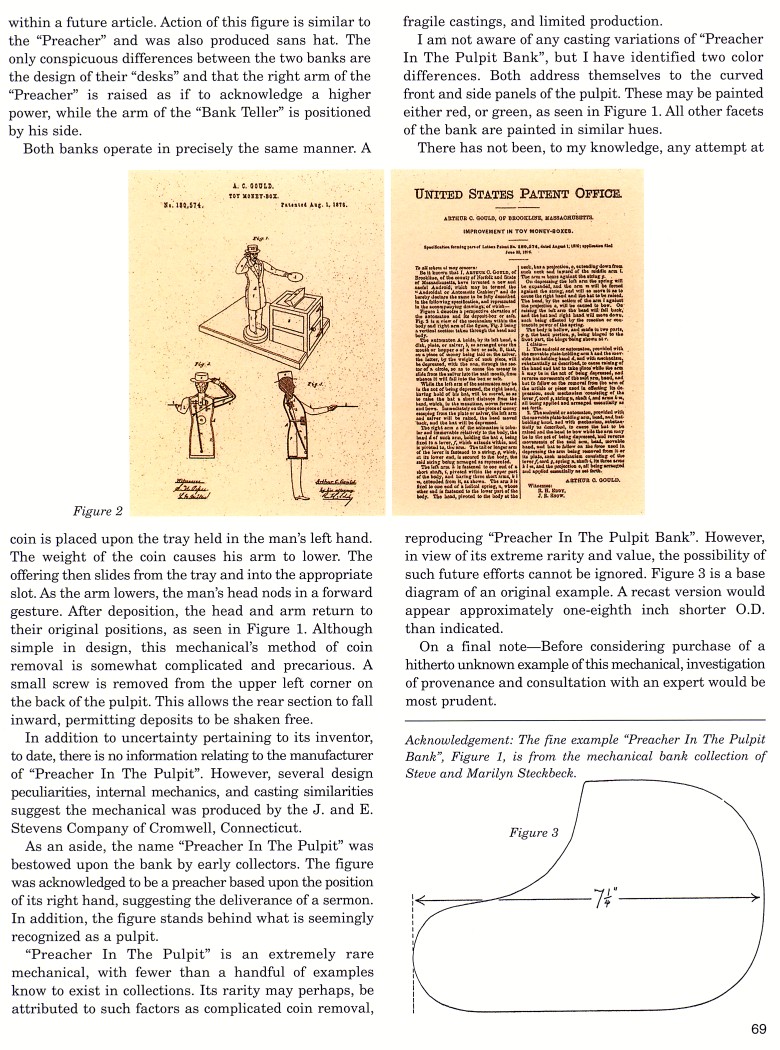|
Preacher in the Pulpit
Bank
by Sy Schreckinger – ANTIQUE TOY WORLD Magazine – August, 2004
Mechanical bank designers of the late nineteenth and early
twentieth centuries were inundated with subjects and a wealth of ideas.
Their products reflected timely and popular themes such as childhood
activities, circus acts, wild and exotic animals, architectural
structures, etc.
Interestingly, one topic that appears sparse in the number of
resultant mechanicals is that of a theological or religious nature. In
addition to one such member of this group and the subject of this article,
"Preacher In The Pulpit Bank" (Figure 1), other notables include "Jonah
and the Whale Bank" (Shepard Hardware Company), "Church Bank, Woman With
Bible" (Gebruder Bing), "Tin, Musical Church Bank", plays Silent Night
(Karl Rohreseitz), "Musical Church Bank", wood (manufacturer unknown),
"Bird on Roof" (J. and E. Stevens), and "Mosque Bank" (Judd Manufacturing
Company).
"Preacher In The Pulpit Bank", Figure 1, was assumedly invented by
Arthur C. Gould of Brookline, Massachusetts. Patent number
180,574 (Figure
2) was issued to him for a mechanical bank on August 1, 1876. The drawings
portrayed therein illustrate an almost precise duplication of the patented
male figure. However, the patent papers indicate an articulated arm
holding its hat in hand, and a coin receptacle depicted as a money safe.
This same male figure had been utilized in another mechanical, namely
the "Bank Teller Bank" (to be discussed within a future article. Action of
this figure is similar to the "Preacher" and was also produced sans hat.
The only conspicuous differences between the two banks are the design of
their "desks" and that the right arm of the "Preacher" is raised as if to
acknowledge a higher power, while the arm of the "Bank Teller" is
positioned by his side.
Both banks operate in precisely the same manner. A coin is placed
upon the tray held in the man's left hand. The weight of the coin causes
his arm to lower. The offering then slides from the tray and into the
appropriate slot. As the arm lowers, the man's head nods in a forward
gesture. After deposition, the head and arm return to their original
positions, as seen in Figure 1. Although simple in design, this
mechanical's method of coin removal is somewhat complicated and
precarious. A small screw is removed from the upper left corner on the
back of the pulpit. This allows the rear section to fall inward,
permitting deposits to be shaken free.
In addition to uncertainty pertaining to its inventor, to date, there
is no information relating to the manufacturer of "Preacher In The
Pulpit". However, several design peculiarities, internal mechanics, and
casting similarities suggest the mechanical was produced by the J. and E.
Stevens Company of Cromwell, Connecticut.
As an aside, the name "Preacher In The Pulpit" was bestowed upon the
bank by early collectors. The figure was acknowledged to be a preacher
based upon the position of its right hand, suggesting the deliverance of a
sermon. In addition, the figure stands behind what is seemingly recognized
as a pulpit.
"Preacher In The Pulpit" is an extremely rare mechanical, with fewer
than a handful of examples know to exist in collections. Its rarity may
perhaps, be attributed to such factors as complicated coin removal,
fragile castings, and limited production.
I am not aware of any casting variations of "Preacher In The Pulpit
Bank", but I have identified two color differences. Both address
themselves to the curved front and side panels of the pulpit. These may be
painted either red, or green, as seen in Figure 1. All other facets of the
bank are painted in similar hues.
There has not been, to my knowledge, any attempt at reproducing
"Preacher In The Pulpit Bank". However, in view of its extreme rarity and
value, the possibility of such future efforts cannot be ignored. Figure 3
is a base diagram of an original example. A recast version would appear
approximately one-eighth inch shorter O.D. than indicated.
On a final note — Before considering purchase of a hitherto unknown
example of this mechanical, investigation of provenance and consultation
with an expert would be most prudent.
Acknowledgement: The fine example "Preacher In The Pulpit Bank",
Figure 1, is from the mechanical bank collection of Steve and Marilyn
Steckbeck.
|


